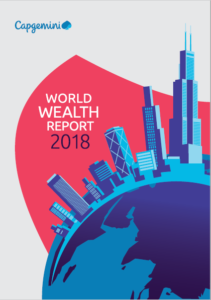“North America accounts for 31.3% of global HNWI population and 28.2% of wealth. The HNWI population in North America grew by 9.9% in 2017 as compared to 7.8% the previous year, while HNWI financial wealth grew at 10.3% to reach US$19.8 trillion. -Anirban Bose
 What is this article?
What is this article?
The 2018 World Wealth Report gleans data from more than 2,600 surveys from around the world to report on trends for high net worth individuals (HNWI) and ultra-HNWIs. The report provides insights into asset allocations and investment preferences, such as working with wealth managers and the growing interest in cryptocurrencies.
Capgemini defines HNWIs as those having investable assets of US$1 million or more, excluding primary residence, collectibles, consumables, and consumer durables.
What are key findings from the article?
- Global HNWI wealth grew 10.6% to surpass the US$70 trillion mark and remains on course to reach US$100 trillion by 2025, with the Asia-Pacific region leading the way.
- Asia-Pacific and North America fueled the 2017 growth in HNWI population and wealth, with Asia-Pacific accounting for 42.4% of the rise in HNWI wealth and North America accounting for 27.4%.
- The US, Japan, Germany, and China are the four largest markets for HNWIs, with the US leading at 5.3 million in 2017, a 10% increase over 2016. Guidestar estimates the number of active US nonprofits courting these individuals at more than 1.8 million, so there is great competition to secure funding from these individuals.
- Though asset allocation remained fairly stable, real estate saw a significant increase in HNWI asset allocation in 2017, with an increase of 2.8 percent globally to 16.8%, becoming the third-largest asset class, behind equities and cash.
- In North America, real estate represents 12.4% of HNWI assets, with residential real estate dominating the class at 52.3% – followed by 16.1% in commercial real estate (excluding hotels), 10.2% in land, 7.0% in farmland, and 5.6% in hotels.
- HNWIs are becoming interested in investing in cryptocurrencies though the wealth management industry remains cautious because of regulatory uncertainty.
- Wealth management firms are preparing for the entry of BigTech, which Capgemini defines as data-driven tech firms not traditionally present in financial services such as Amazon, Google/Alphabet, Alibaba, Apple, and Facebook. Leading wealth management firms are investing in intelligent automation and artificial intelligence to prepare for the greater role that BigTech firms will play.
What can I do as a result?
- Except in cases of public company insiders, the two biggest asset classes, equities and cash, are not readily transparent to a prospect researcher. Real estate, on the other hand, remains the most often used asset in determining gift capacity because of its transparency in the US. Capgemini estimates US real estate at 12.4% of a HNWI’s total assets, so this number can be very useful for estimating net worth.
- The US leads the pack in the number of HNWIs – 5.3 million. For those prospecting in the US, there is a vast pool of wealth to tap into. There is also great competition though, with 1.8 million active nonprofits vying for gifts from those individuals.
- With the burgeoning interest of HNWIs in cryptocurrency and BigTech, there will be a need for prospect researchers and fundraisers to understand better how wealth management firms will be leveraging these vehicles.